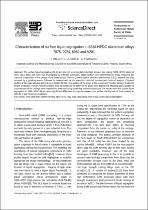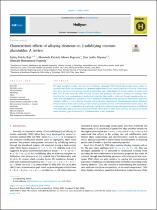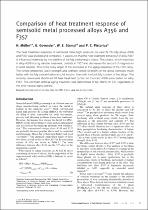 ResearchSpace
ResearchSpace
Characterization of surface liquid segregation in SSM-HPDC aluminium alloys 7075, 2024, 6082 and A201
JavaScript is disabled for your browser. Some features of this site may not work without it.
- ResearchSpace
- →
- Research Publications/Outputs
- →
- Journal Articles
- →
- View Item
| dc.contributor.author |
Moller, H

|
|
| dc.contributor.author |
Curle, UA

|
|
| dc.contributor.author |
Masuku, EP

|
|
| dc.date.accessioned | 2010-09-28T10:41:03Z | |
| dc.date.available | 2010-09-28T10:41:03Z | |
| dc.date.issued | 2010-09 | |
| dc.identifier.citation | Moller, H, Curle, UA and Masuku, EP. 2010. Characterization of surface liquid segregation in SSM-HPDC aluminium alloys 7075, 2024, 6082 and A201. Transactions of Nonferrous Metals Society of China, Vol. 20(3), pp s847-s851 | en |
| dc.identifier.issn | 1003-6326 | |
| dc.identifier.uri | http://www.ysxbcn.com/upfile/soft/201099/26-p847-2082.pdf | |
| dc.identifier.uri | http://hdl.handle.net/10204/4377 | |
| dc.description | Copyright: 1997-2008 Editorial office of Transactions of Nonferrous Metals Society of China | en |
| dc.description.abstract | Semi-solid metal (SSM) processing is a unique manufacturing method to produce near-net shape products for various industrial applications. The nature of the SSM slurry (with solid spherical grains suspended in a liquid), makes it susceptible to liquid segregation during forming processes such as high pressure die casting (HPDC). In this paper, the SLS phenomenon in SSM-HPDC plates of 7075, 2024, 6082 and A201 was investigated by means of different techniques. Depth profiles were determined by firstly measuring the chemical composition of the surface of the plates using a Thermo Quantris Optical Emission Spectrometer (OES). Material was then removed by a grinding process followed by measurement of the amount of material removed and chemical analysis. Chemical profiles of the main alloying elements were plotted for the cross-section of the plates in the as-cast and T6 (after solution treatment) temper conditions. Vickers hardness profiles from the surface to the centre of the plates were determined. Metallographic samples of cross-sections of the castings were prepared and evaluated using a scanning electron microscope. It is shown that surface liquid segregation in SSM-HPDC alloys causes significant differences in properties between the surface and the bulk of these castings in both the F and T6 temper conditions. | en |
| dc.language.iso | en | en |
| dc.publisher | Editorial office of Transactions of Nonferrous Metals Society of China | en |
| dc.subject | Semi-solid metal | en |
| dc.subject | Alloy 7075 | en |
| dc.subject | Alloy 2024 | en |
| dc.subject | Alloy 6082 | en |
| dc.subject | Alloy A201 | en |
| dc.subject | Surface liquid segregation | en |
| dc.subject | Nonferrous metals | en |
| dc.subject | Aluminium alloys | en |
| dc.title | Characterization of surface liquid segregation in SSM-HPDC aluminium alloys 7075, 2024, 6082 and A201 | en |
| dc.type | Article | en |
| dc.identifier.apacitation | Moller, H., Curle, U., & Masuku, E. (2010). Characterization of surface liquid segregation in SSM-HPDC aluminium alloys 7075, 2024, 6082 and A201. http://hdl.handle.net/10204/4377 | en_ZA |
| dc.identifier.chicagocitation | Moller, H, UA Curle, and EP Masuku "Characterization of surface liquid segregation in SSM-HPDC aluminium alloys 7075, 2024, 6082 and A201." (2010) http://hdl.handle.net/10204/4377 | en_ZA |
| dc.identifier.vancouvercitation | Moller H, Curle U, Masuku E. Characterization of surface liquid segregation in SSM-HPDC aluminium alloys 7075, 2024, 6082 and A201. 2010; http://hdl.handle.net/10204/4377. | en_ZA |
| dc.identifier.ris | TY - Article AU - Moller, H AU - Curle, UA AU - Masuku, EP AB - Semi-solid metal (SSM) processing is a unique manufacturing method to produce near-net shape products for various industrial applications. The nature of the SSM slurry (with solid spherical grains suspended in a liquid), makes it susceptible to liquid segregation during forming processes such as high pressure die casting (HPDC). In this paper, the SLS phenomenon in SSM-HPDC plates of 7075, 2024, 6082 and A201 was investigated by means of different techniques. Depth profiles were determined by firstly measuring the chemical composition of the surface of the plates using a Thermo Quantris Optical Emission Spectrometer (OES). Material was then removed by a grinding process followed by measurement of the amount of material removed and chemical analysis. Chemical profiles of the main alloying elements were plotted for the cross-section of the plates in the as-cast and T6 (after solution treatment) temper conditions. Vickers hardness profiles from the surface to the centre of the plates were determined. Metallographic samples of cross-sections of the castings were prepared and evaluated using a scanning electron microscope. It is shown that surface liquid segregation in SSM-HPDC alloys causes significant differences in properties between the surface and the bulk of these castings in both the F and T6 temper conditions. DA - 2010-09 DB - ResearchSpace DP - CSIR KW - Semi-solid metal KW - Alloy 7075 KW - Alloy 2024 KW - Alloy 6082 KW - Alloy A201 KW - Surface liquid segregation KW - Nonferrous metals KW - Aluminium alloys LK - https://researchspace.csir.co.za PY - 2010 SM - 1003-6326 T1 - Characterization of surface liquid segregation in SSM-HPDC aluminium alloys 7075, 2024, 6082 and A201 TI - Characterization of surface liquid segregation in SSM-HPDC aluminium alloys 7075, 2024, 6082 and A201 UR - http://hdl.handle.net/10204/4377 ER - | en_ZA |








